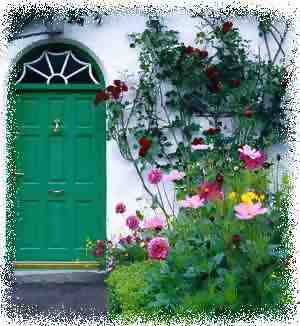Home Garden Design


Creating a home garden with landscaping allows you to bring nature close to your home. Your home garden is an extension of your living space. Some of us would prefer the traditional formal gardens while others revel in the asymmetrical yet inviting home gardens. A small herb garden can provide you with valuable natural aids. There is no dearth of home gardening ideas. Find out how to embark on this project and even create an energy efficient home in the process. Home garden design software packages aid the process of laying out gardens based on the topography and climatic conditions.
Purpose of the home garden
Determining the purpose or function of your garden is the first step towards designing your home garden. The location and size of your yard are the primary factors influencing the home garden landscaping. Based on this, you can decide on the type of garden you want, be it a breathtaking floral view or an abundant vegetable yield or a quaint cottage garden or herb garden. Home garden designs can be broadly classified into two styles - formal style and informal style.
Formal style of home garden involves a traditional garden containing elements such as geometrically shaped planting beds (usually filled with bedding plants that are changed two or three times a year), clipped hedges, topiaries (shrubs trained and pruned to a fanciful shape), walkways, walls and usually a lawn. This type of home garden design works on a central axis running down the exact center. However informal gardens have a lot of benefits and ideal for those seeking a more relaxed ambience. You have a range of choices - from wildflower meadows to fashioned wooden areas or miniature wooden gardens.
Site Analysis
The location of your garden is a critical factor when you consider home garden layouts. Monitor the site during different times of the day and year. Since most plants species thrive in good sunlight, you need to graph the yard to check out the amount of sunlight that each area gets. The soil and its properties such as texture and pH must also be taken in to consideration.
Maintenance
When planning the landscaping for your home garden, keep in mind the amount of time you can spend for its maintenance and upkeep. The size and complexity of any home garden plan hinges on the required maintenance.
Plant Selection
Plant selection is the final and important stage in your home garden plans.
- Keep in mind what your garden will be used for and when.
- If you plan to entertain a lot, look for lower maintenance plants that don't require constant tending and upkeep.
- If you are planting for small children, choose plants that will bloom at their eye level, with interesting textures and scents. Ensure that you plant non-poisonous flowers and seeds.
- Make a list of the plants you like and group them by color, texture and form. Chart them by season of bloom and interest. Consider both flowers and foliage. Plants with colorful foliage make for an aesthetically appealing yard.
- Be sure to include some large anchor plants that will look good all year. These are usually shrubs and evergreens. Most gardens can only accommodate 1 or 2 trees or shrubs, but they are important for providing the focal point of a home garden.
- Research the bloom times of different plants to determine during which season blossoms will emerge. After the spring panorama fades, you will be able to introduce a fresh new landscape with summer blooming species such as a Weigela bush or Shasta Daisies.
- Choosing a variety of plants to maintain blossoms throughout the year will keep your landscape looking new and revitalized year round.
Home Garden Plan
Home garden planning helps you to prepare a blue print of your garden. There is no dearth of home garden planning software that will aid you in the process. These are available in 2D to 3D versions. You can use the variety of built-in designs that come along with the program or you can create your own. Home garden software offers extensive drawing tools, symbols and user-friendly wizards to design your dream garden.
They also provide a comprehensive plant database to help in selecting your home garden plans. Apart from extensive drawing tools and wizards, some of these design packages also include plant encyclopedia, plant care calendar, seasonal garden views and plant gardens.
Home Garden Landscaping
Home garden landscaping can add beauty, value and functionality not only to the garden but also to the home as a whole. Home garden landscaping can be undertaken as a do-it-yourself schemes or you can employ a landscaping firm to get it done. You need to start off with a budget for your home garden plans. Home garden landscaping includes basic elements:
- Color
- Form
- Line
- Scale
- Texture
These five elements are critical when designing the gardens, lawns, shrubs and trees. The shape of a tree and its branching pattern needs to be taken into consideration. trees come in many shapes - columnar, conical and globular shapes. tree forms range from the stiffly upright branches of a European poplar to the droopy quality of a weeping willow.
Similarly line refers to the fact that the viewer's eye movement or flow can be governed by the arrangement of plants and their borders. Eye movement is unconsciously influenced by the way plant groupings fit or flow together, both on a horizontal and vertical plane. Plant texture is another critical visual element in landscape designing.
- Deciduous trees can be planted to the south and west of a home to serve as shade trees, reducing summer air conditioning costs. Because such trees will drop their leaves in winter, they won't deprive your home of sunlight when you need it.
- Evergreen trees planted to the north and west of a home can serve as windbreaks, which will reduce your heating costs in winter.
- Likewise, shrubs used as foundation plantings can reduce heating costs, creating an insulating dead air space around the home. Plant the shrubs a few feet away from your foundation.
Achieve unity in the home garden landscaping by placing individual components that are cohesive. Balance can be sought in a home garden design by either symmetrical duplication or asymmetrical landscape components. Asymmetry helps in lending a more relaxed and natural ambience to the home garden plan. Carefully positioned trees, shrubs or vines can deliver effective shade, act as a windbreak and reduce overall energy bills.
try to incorporate energy efficiency into your home garden design. Those living in hot areas can benefit from using the sun's energy to decrease heat build up in the home by providing appropriate shade and evaporative cooling. Energy conserving landscaping for your home garden will depend on the climate and topography you live in.
Top of the Page: Home Garden Design
Tags:#home garden design #home garden plan #home garden landscaping
 Home and Garden
Home and Garden Apartment Decor
Color Decorating Schemes
Loft Decor
Decorating Small Space
Floor Decor
Halloween Decoration
Driftwood Home Accents
Wood Paneling
Artificial Christmas Tree
Christmas Ornament
Steel entry door
Home Improvement Catalog
Interior Decorating Idea
Sunroom Designs
Master Bedroom Ideas
Kid Room Décor
Country Home Décor
Lodge Décor
Beach House Decorating
Laundry Room Decor
Moroccan Decor
Japanese Décor
Living Room Makeover
Nautical Home Décor
Home Improvement Tips
Do it yourself Home Improvement
Kitchen Remodeling Idea
Home Improvement Contractor
Home Garden Design
Lower Energy Bills
Laminate flooring
...
Thanksgiving Decoration
Furnitures
 Home Furnishing Idea
Home Furnishing Idea Sectional Sofas
Leather Sofa
Furniture Arrangement
Hammock
Armoire
Dresser
Home Bar
Door Knocker
Footstool
Wood Bookcase
Rice Paper Blinds
Table Decoration
Christmas Centerpiece
Rattan Furniture
Top of the Page: Home Garden Design
Popularity Index: 100,867

